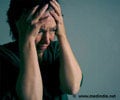A new study says that scientists may be able to develop more effective anaesthetics and stimulants by studying the brain's waking and dreaming mechanisms.

"While we used to believe this system worked like a hammer hitting a bell, causing the cortex to ring, we now find that it is like the hammer itself is also ringing," said Edgar Garcia-Rill, Ph.D., director of the center and a professor in the Department of Neurobiology and Developmental Sciences of the UAMS College of Medicine.
Electrodes on scalp measured waves of brain activity at 10 Hertz while asleep, and 20-40 Hertz when awake. The 20-40 Hertz range is called the gamma band activity, which is exhibited by parts of the reticular activating system, the part of the brain responsible for regulating arousal and waking.
"This means that the reticular activating system activates the rest of the brain when we are alerted, and it does so, not by triggering such activity in other regions, but by itself generating gamma band activity," Garcia-Rill said.
Garcia-Rill said that while the activity of the cells usually increases in frequency, in this case it stays fairly consistent.
"Being able to manipulate that frequency holds the key to new stimulants or anaesthetics through development of medications that could block or induce that activity - and thus control waking and sleeping more effectively," Garcia-Rill said.
Advertisement
Source-ANI














